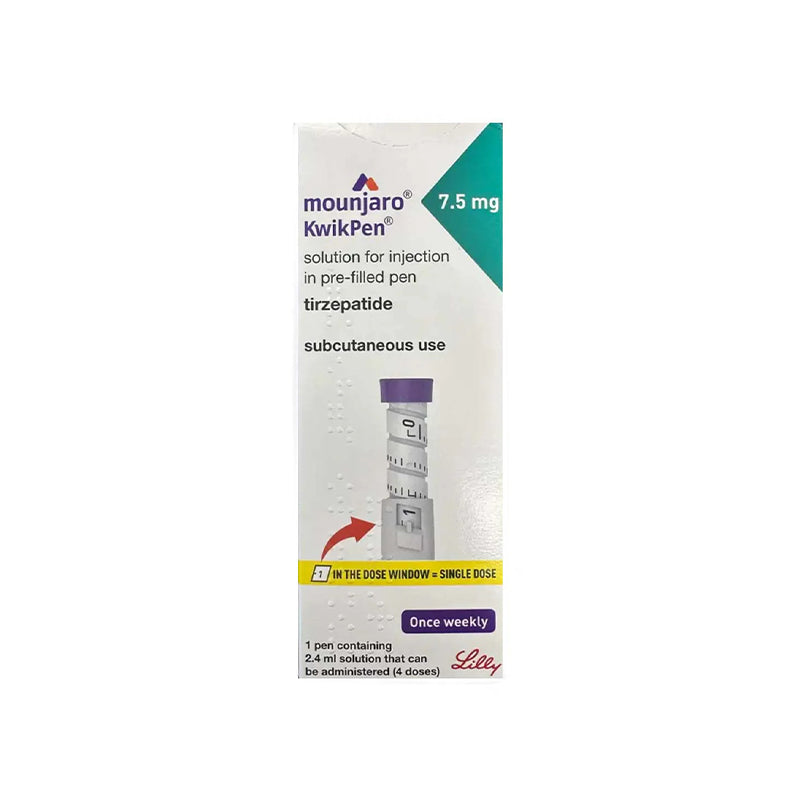-
Media gallery  Media gallery
Media gallery
MOUNJARO KWIKPEN 7.5/0.6ML SOLUTION INJ PEN 1'S
- Regular price
- QAR 1,856.00
- Regular price
-
- Sale price
- QAR 1,856.00
- Unit price
- / per
Couldn't load pickup availability
Description
Description
Mounjaro (tirzepatide) 2.5 mg, 5 mg, 7.5 mg, 10 mg, 12.5 mg, and 15 mg per 0.5 mL injection, is a prescription medicine for adults with type 2 diabetes used along with diet and exercise to improve blood sugar (glucose). It is not known if Mounjaro can be used in people who have had pancreatitis. Mounjaro is not for use in people with type 1 diabetes. It is not known if Mounjaro is safe and effective for use in children under 18 years of age.1
It is a single molecule designed to bind to glucose-dependent insulinotropic polypeptide (GIP) and glucagon-like peptide-1 (GLP-1) receptor agonists.2
Mounjaro represents a different class of medicines introduced for adults with type 2 diabetes. It works differently by directly activating GIP and GLP-1 pathways to help regulate blood sugar.
DIRECTIONS TO USE :
Use Mounjaro exactly as your healthcare provider says.
Mounjaro is injected under the skin (subcutaneously) of your stomach (abdomen), thigh, or upper arm.
SIDE EFFECTS :
Inflammation of the pancreas (pancreatitis). Stop using Mounjaro and call your healthcare provider right away if you have severe pain in your stomach area (abdomen) that will not go away, with or without vomiting. You may feel the pain from your abdomen to your back.
Low blood sugar (hypoglycemia). Your risk for getting low blood sugar may be higher if you use Mounjaro with another medicine that can cause low blood sugar, such as a sulfonylurea or insulin. Signs and symptoms of low blood sugar may include dizziness or light-headedness, sweating, confusion or drowsiness, headache, blurred vision, slurred speech, shakiness, fast heartbeat, anxiety, irritability, or mood changes, hunger, weakness and feeling jittery.
Serious allergic reactions. Stop using Mounjaro and get medical help right away if you have any symptoms of a serious allergic reaction, including swelling of your face, lips, tongue or throat, problems breathing or swallowing, severe rash or itching, fainting or feeling dizzy, and very rapid heartbeat.
Kidney problems (kidney failure). In people who have kidney problems, diarrhea, nausea, and vomiting may cause a loss of fluids (dehydration), which may cause kidney problems to get worse. It is important for you to drink fluids to help reduce your chance of dehydration.
Severe stomach problems. Stomach problems, sometimes severe, have been reported in people who use Mounjaro. Tell your healthcare provider if you have stomach problems that are severe or will not go away.
Changes in vision. Tell your healthcare provider if you have changes in vision during treatment with Mounjaro.
Gallbladder problems. Gallbladder problems have happened in some people who use Mounjaro. Tell your healthcare provider right away if you get symptoms of gallbladder problems, which may include pain in your upper stomach (abdomen), fever, yellowing of skin or eyes (jaundice), and clay-colored stools.
Common side effects
The most common side effects of Mounjaro
Delivery & Returns
Delivery & Returns
Delivery in Qatar: All orders are delivered within 1 - 3 hours maximum to anywhere in Qatar, delivery is available 24 hours a day.
Express Delivery ( 1 Hour )Terms & Conditions Apply
Returns & Exchanges
Unopened items in saleable condition can be returned or exchanged within 7 days from date of purchase, except refrigerated medicines and wearable items.
Payment Methods
Payment Methods
- Apple Pay & Google Pay
- Online Payment via Credit/Debit card

Have a question?
Notified by email when this product becomes available

QAR 1,856.00
- Product Reviews
- Privacy policy
Shipping cost is based on weight. Just add products to your cart and use the Shipping Calculator to see the shipping price.
We want you to be 100% satisfied with your purchase. Items can be returned or exchanged within 30 days of delivery.
Recently viewed product
Featured Collection
Sentinel Stress 600+Biotin Tab 60'S
- Regular price
- QAR 37.00
- Regular price
-
- Sale price
- QAR 37.00
- Unit price
- / per
BIODERMA PHOTODERM CREAM MAX SPF100+ 40 ML
- Regular price
- QAR 135.00
- Regular price
-
- Sale price
- QAR 135.00
- Unit price
- / per
EUCERIN SUN FACE CREAM SPF 50+50 ML
- Regular price
- QAR 134.00
- Regular price
-
- Sale price
- QAR 134.00
- Unit price
- / per
Nature's Bounty Biotin 5000 MCG Rapid Release Softgels
- Regular price
- QAR 47.00
- Regular price
-
- Sale price
- QAR 47.00
- Unit price
- / per
PANADOL BABY AND INFANT 100 ML
- Regular price
- QAR 7.00
- Regular price
-
- Sale price
- QAR 7.00
- Unit price
- / per
Sentinel Probiotic 60 Capsules
- Regular price
- QAR 72.00
- Regular price
-
- Sale price
- QAR 72.00
- Unit price
- / per







